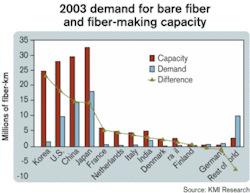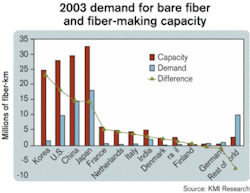Fiber capacity still in excess
Despite reductions in manufacturing capacity and consolidation in the industry, there is still a worldwide excess of fiber capacity, observes KMI Research (Providence) in a new report, "Worldwide Optical Fiber and Cable Markets: Market Developments and Forecasts."
While the last fiber shortage ended two and a half years ago, demand has continued to decline since then, forcing fiber manufacturers to reduce their capacity or consolidate operations. From 2002 to 2003, for example, worldwide fiber-making capacity decreased from 167 million to 145 million fiber-km. Fiber demand in '03 topped out at 63.5 million fiber-km, meaning less than half of the world's capacity was used.A combination of lower prices and lower unit-quantity shipments reduced the market for bare fiber to $1.3 billion last year, down 21% from 2002. The fiber-optic-cable market decreased 33%, thanks to increased competition among more suppliers for fewer end users.
The problems of matching capacity to demand levels vary by region and country, adds the report. Asia accounted for 63% of cabled-fiber demand last year but is home to the country with the lowest rate (6%) of domestic demand relative to capacity: Korea. From 2001 to '03,
Korean fiber manufacturers as a group more than doubled their capacity to almost 25 million fiber-km. Domestic demand was only 1.5 million fiber-km, however, suggesting that some rationalization of fiber capacity should occur in Korea.
Fiber capacity in Japan was reduced 13% with the closing of Furukawa's Mie facility. Capacity in China, meanwhile, increased by 150% from '01 to '03, reaching 29.5 million fiber-km last year. If domestic suppliers alone served China and Japan's fiber requirements, then China's capacity utilization would be 50% and Japan's, 55%.
China, Japan, and Korea together account for 87 million fiber-km, or 60% of the '03 worldwide capacity of 145 million fiber-km. The United States currently has the third largest domestic capacity after Japan and China. As a group, China, Japan, Korea, and the U.S. represent 79% of the world's fiber-making capacity.
For more details on the report, visit www.kmiresearch.com.

